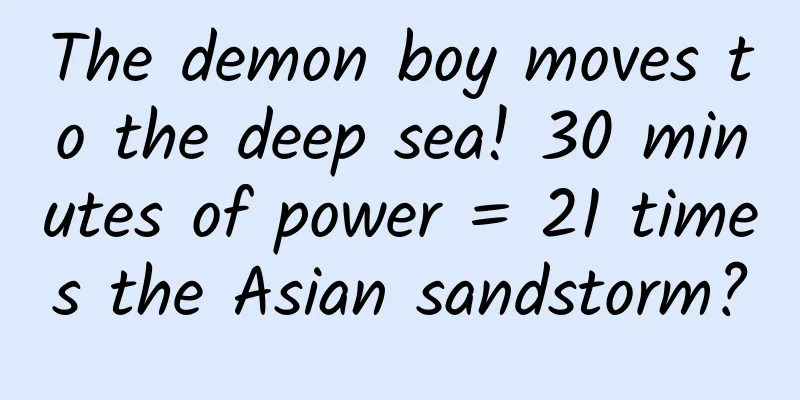The demon boy moves to the deep sea! 30 minutes of power = 21 times the Asian sandstorm?

|
Nezha 2 has swept the world at the box office, and the movie has reinterpreted and presented "Nezha's Trouble in the Sea". According to the Ming Dynasty novel "Investiture of the Gods", Nezha "released the seven-foot Chaos Heaven Ribbon into the sea, swinging it to make rivers and shaking the universe. Before he knew it, the Crystal Palace was shaking..." Nezha's "harmless" action of bathing at the seaside turned into a devastating storm in the deep sea. Source: Stills from "Nezha Conquers the Dragon King" (1979) Modern ocean physics has discovered that high-speed deep-sea currents can cause "huge waves" of seabed sediments. So is it possible that the underwater Dragon Palace was hit by an unprecedented "undersea storm"? 01. Can typhoons also blow in the deep sea? Ocean currents, also known as sea currents, refer to large-scale seawater movements with relatively stable flow speeds and directions. In the past, people's understanding of ocean currents was mostly focused on the surface seawater, such as the cold currents and warm currents we are familiar with. The deep sea should be quiet - so quiet that you can build a dragon palace there. Since the 1960s, scientists have confirmed the existence of deep-sea currents through direct measurements of the deep sea. Most of the time, the flow rate of deep-sea currents is relatively stable, but once the flow rate suddenly increases, it will disperse the sediments on the seabed to form a mist layer, and the concentration of suspended particles in the mist layer will increase exponentially. The North Atlantic High Energy Bottom Boundary Layer Experiment (HEBBLE) project observed at a depth of 5,000 m on the seabed that the concentration of suspended particles during submarine storms reached as high as 12,000 μg/L. This phenomenon is similar to storms occurring in the atmosphere and is therefore likened to a "submarine storm." 02. Who is stirring up the seabed? The answer is definitely not Nezha. Scientists believe that the formation of "undersea storms" is related to the transfer of eddy kinetic energy from the ocean surface to the deep seabed. This involves many complex factors. When the seawater in the polar regions freezes, the salt remains in the seawater, so the surface seawater is cold and salty, and has a greater density than the deep seawater, so it will flow downward. At the same time, due to the action of wind, the seawater has horizontal movement, which will form vortices. The continuous vortex movement of seawater over a large area will drive the flow rate of the bottom seawater to accelerate. Another influencing factor is atmospheric storms. When atmospheric storms continue to visit a certain sea area, the more violent the waves are, the more energy is transferred to the seabed. Under the combined effects of bottom currents, ocean currents and vortices, the speed of deep-sea currents suddenly increases, causing the seabed sediments to be stirred up, forming a "seabed storm." Source of the hurricane-affected deep-sea current map: https://www.whoi.edu/ 03. How does the power of the underwater storm compare to Nezha’s Conquering the Dragon King? When talking about Nezha's Trouble in the Sea, the scenes of the overturned Dragon Palace and Ao Bing's tragic death are impressive. But you may not know that the power of nature is equally amazing - the destructive power of deep-sea storms is enough to compete with Nezha. When an "undersea storm" breaks out, its flow rate can reach an average of 50 cm/s. Although this speed is almost negligible compared to the 25 m/s of a typhoon, the energy it generates is very terrifying. Let's first understand two formulas: E=½mv², m=ρV (E represents energy, m represents mass, v represents speed, ρ represents density, and V represents volume). It can be seen that kinetic energy is proportional to the square of density and speed. Since the density of seawater is 1,000 times that of air, even if the flow rate is only 1/50 of that of a typhoon, its kinetic energy may still reach the level of a typhoon, and the huge energy is enough to destroy the ecosystem and human facilities on the seabed. In addition, although the submarine storm does not last long (generally no more than half an hour), according to the latest observational research on the deep South China Sea, the suspended flux created by the submarine storm phenomenon caused by solitary waves in the South China Sea is at the same order of magnitude as the global dust storm emissions, 21.9 times the amount of sandstorms entering the sea in Asia, and about 21 times the flux of river sediments entering the sea in the northern South China Sea. After the storm, the seabed creatures, rocks, underwater scientific instruments and deep-sea communication cables will all be buried under thick sediments. The seafloor is covered by suspended debris during an undersea storm Image source: sciencedirect.com Do you think the deep sea is only filled with undercurrents and "undersea storms"? That's just the tip of the iceberg! In the abyss where the sun never shines, there are also hidden things - the "golden hoop" that records information about the ancient earth, treasures from a shipwreck that has been sleeping for a hundred years, and strange creatures that live in temperatures of 400℃. The Shanghai Science and Technology Museum and Tongji University have jointly created a popular science short video "Nature in Your Pocket" special edition of "Deep Sea"! 15 mysteries hidden in the deep sea are about to be unlocked. Do you dare to dive into the 10,000-meter abyss with us? This September, you will find out the answer! References [1] Jian Zhimin, Huang Wei, Li Jiabiao. Geoscience Revolution from the Seabed[M]. Beijing: Ocean Press, 2023. [2] Wilford D. Gardner, et al. "Benthic storms, nepheloid layers, and linkage with upper ocean dynamics in the western North Atlantic." Marine Geology 385. (2017): 304-327. [3] Liu Zhifei, Zhang Yanwei, Zhao Yulong. In situ observation of deep-sea storms[J]. Science and Technology Review, 2020, 38(18): 26-29. [4] Jia Yonggang, Feng Xuezhi, Zhu Chaoqi, Wang Linsen, Liu Xiaolei, Hu Cong & Wang Hongwei. Solitary waves in the Shenhu shelf slope break region in the northern South China Sea induce submarine storms. Science China: Earth Sciences, 1-15. Author: Zhang Ping, Librarian of Science Communication Center, Shanghai Science and Technology Museum Editor: Tinker Bell Acknowledgements: Huang Wei, Associate Professor of the School of Ocean and Earth Sciences at Tongji University, provided scientific guidance for this article. Cover source: Stills from the film Nezha Conquers the Dragon King (1979) produced by Shanghai Animation Film Studio |
>>: Every year, 650,000 people die from influenza worldwide, while tuberculosis kills 1.25 million!
Recommend
What does a chicken go through before it reaches the table? Watch this and eat a chicken drumstick!
When you are enjoying a chicken drumstick in your...
Dismantling Spark Education’s K12 Education Operation Growth Strategy
Today's case comes from Chen Xi, an outstandi...
CountdownTimer usage and principle analysis
[[436754]] This article is reprinted from the WeC...
Why has the British Museum come to this? The original intention behind its more than 8 million collections has disappeared!
You must have heard “The best cultural relics in ...
The reason why Android is lagging more than iOS has been found: it uses nearly 3 times more memory
When we mention Android and iOS, many people'...
How do I summarize and organize materials as a new media operator?
A long time ago, I asked a senior, what is operat...
Let’s talk about how to increase followers on apps like Tik Tok and Zhihu!
Today let’s talk about the issue of increasing fo...
The "diving" cooling is coming! Doctors remind you to protect these 5 parts of your body!
Some time ago, the temperature soared in many pla...
Have you fallen into these 5 pitfalls of community operations?
Because it's simple, everyone wants to do it....
When will Changchun City be able to lift the lockdown in 2022? When exactly will work and production resume? Attached the latest news
At present, the epidemic situation in Jilin Provi...
How to achieve passive traffic and fan acquisition through Baidu drop-down box search?
When we search for online promotion on Baidu, som...
Tips for Protocol-Oriented Programming (POP) in Swift
1. Entrustment Model 1. Usage process The most co...
"Losing weight" is a big deal! These 6 wrong ways to lose weight may ruin you
Being fat may sound like a trivial matter, but it...
How to find the best selling point in 15 minutes? This is what the boss thinks...
Have you ever had this experience , your boss cal...
Brand Marketing: Why is “What’s Peppa Pig?” so popular?
When " Peppa Pig tattoo, applause to the soc...









